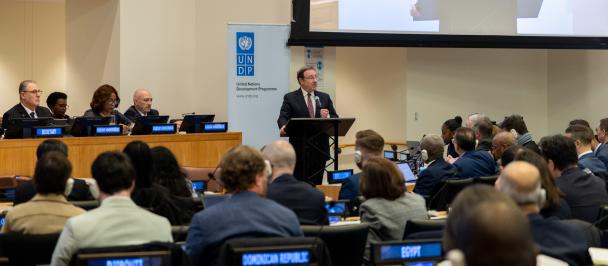Remarks at High Level event on the New Way of Working: “From vision to action - national, regional and global dimensions”
From vision to action
January 28, 2018
As prepared for delivery.
Excellencies, Ministers, distinguished panelists, colleagues and friends.
Thank you to the Government of Ethiopia for hosting this important high-level event on the New Way of Working and for re-affirming their commitment to the Agenda for Humanity and the outcomes of the World Humanitarian Summit. More importantly, I thank you for your commitment to the 2030 Agenda, for which the New Way of Working aims to meet needs and reduce risk and vulnerability. It provides a reference frame for both humanitarian and development actors to contribute to the common vision of a future in which no one is left behind.
The New Way of Working can be described as working over multiple years, based on the comparative advantages of a diverse range of actors, towards collective outcomes. Context matters considerably in the operationalization of the New Way of Working, so it is not a one size fits all approach.
As the world continues to be impacted by climatic change and climate shocks, especially drought episodes that have become more frequent and severe, there is a need to plan better to reduce the suffering and vulnerability of populations. The New Way of Working provides a pathway to dealing with the multifaceted challenges of protracted crisis, including shrinking humanitarian emergency aid, by investing in long-term resilience building.
As the UN Secretary-General has outlined, the three imperatives for operationalization of the New Way of Working are: first, to advance national ownership, both the UN and development partners are to play a catalytic role in strengthening national capacities for operationalizing the New Way of Working; second, joint planning and shared analysis is important to ensure that our programming and implementation modalities are context-specific and development investment must be directed to those areas in higher need; third, there is a need for financing architecture that takes into account the principles of predictability, flexibility and use of multi-year financing modalities.
The operationalization of the New Way of Working is excelling in Ethiopia and one can easily see the impact on the ground. This is my first visit to Ethiopia as UNDP Administrator and I am struck by the tremendous strength and resilience of the Ethiopian people in the face of adversity caused by increasingly frequent and extreme weather events.
During the field visit to the sites severely impacted by the droughts, we witnessed that most pastoralists who lost their livestock now rely on humanitarian support, and that this will be exacerbated by the effects of La Nina in reducing rainfall. Nevertheless, we saw examples of coping mechanisms whereby people through practical adaptation measures and using scarce resources economically have been able to increase their farm output to sustain their families. It is upon government, humanitarian and development partners to use these practical examples informed by local risk factors to scale them up, doing this in an integrated fashion taking into account context specificities over the long-term. UNDP offers to play its role as integrator and connector to develop country-level platforms with development solutions – including in providing opportunities for livelihood diversification with economic opportunities in the agricultural sector.
In addition, we applaud the Government of Ethiopia for embracing the New Way of Working, especially in its commitment to the Comprehensive Refugee Response Framework (CRRF).
Together with the Emergency Relief Coordinator, we re-affirm our commitment to work towards bridging the divide by planning better, committing to better use of financial resources with stronger development outcomes that address the needs of the vulnerable and populations at risk. UNDP is committed to provide development solutions based on whole-of-government approaches in contributing to the SDG achievement.
For UNDP and our partners, the example of Ethiopia is a test case for putting action behind the New Way of Working. This will shape our engagement moving forward – not just on the ground in Ethiopia and the Horn of Africa – but also for how the UN system and the international community bring together our humanitarian and development efforts for a more comprehensive response to immediate relief needs and longer-term peace and resilience requirements in complex emergencies.

 Locations
Locations



